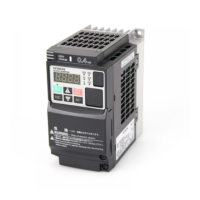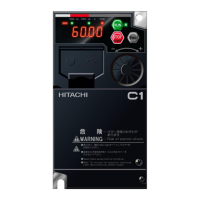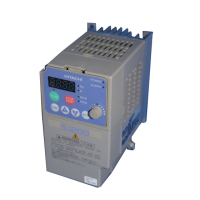40
Frequency arrival output [FA1] uses the
standard output frequency (parameter
F001) as the threshold for switching. In
the figure to the right, Frequency Arrival
[FA1] turns ON when the output
frequency gets within Fon Hz below or
Fon Hz above the target constant
frequency, where Fon is 1% of the set
maximum frequency and Foff is 2% of the
set maximum frequency. This provides
hysteresis that prevents output chatter
near the threshold value. The hysteresis
effect causes the output to turn ON
slightly early as the speed approaches the
threshold. Then the turn-OFF point is
slightly delayed. Note the active low
nature of the signal, due to the open
collector output.
Frequency arrival output [FA2/FA4] works
the same way; it just uses two separate
thresholds as shown in the figure to the
right. These provide for separate
acceleration and deceleration thresholds
to provide more flexibility than for [FA1].
[FA2/FA4] uses / during
acceleration for the ON threshold, and
/ during deceleration for the OFF
threshold. This signal also is active low.
Having different accel and decel
thresholds provides an asymmetrical
output function. However, you can use
equal ON and OFF thresholds, if desired.
As for [FA3/FA5] signal, the basic meaning
of “Fon/Foff” is the same as above.
And, “/ and / are
correlated with [FA2/FA4] signal.
Basically, the meaning of “Fon/Foff” in this
case is the same as above examples, but
there are slight differences from the usage
of [FA2/FA4] signal.
In acceleration status, [FA3/FA5] signal
becomes ON from ("/" - "Fon") to
("/" + "Foff").
In deceleration status, [FA3/FA5] signal
becomes ON from ("/" + "Fon") to
("/" - "Foff").
There is no [FA3/FA5] between "ONs" in
the figure, because frequency arrival
output is out of the area defined by the
sets of parameters.
Fon=1% of max. frequency
Foff=2% of max. frequency
Fon=1% of max. frequency
Foff=2% of max. frequency
Fon=1% of max. frequency
Foff=2% of max. frequency

